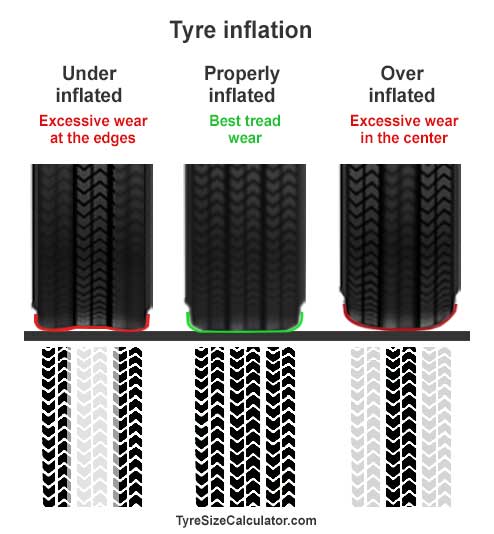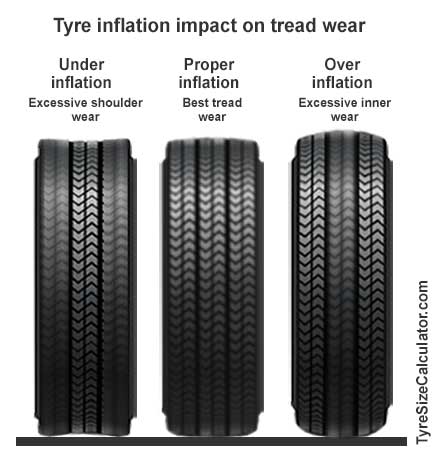Tyres as the only part of the vehicle that is in contact with the ground perform a very important function of carrying the load. Compressed air fills the tyre and carries the overall vehicle weight. Therefore, it is very important to maintain correct tyre pressure.
Tyres are porous and naturally lose air even when they are not being used. Tyres should be neither underinflated nor overinflated but inflated to manufacturers recommended pressure.

What is exactly underinflated tyre?
If a tyre doesn’t have enough air for optimal use, we say the tyre is underinflated. Although there is no generally accepted definition of what is exactly under inflated tyre, but it is considered that the tyre is underinflated when inflated to minimum 25% below manufacturer's recommended inflation pressure (placard recommended pressure). For example, US Federal Motor Vehicle Safety Standard (FMVSS) requires a warning if tires are under inflated by more than 25%.
Severely underinflated tyre is a tyre under inflated by 50 kPa (0.5 Bar or 7.25 psi ) or more below the recommended pressure.
Moderate underinflated tyre is a tyre in the range 20-49 kPa (0.2-0.49 Bar or 2.90-7.11 psi) under the recommended pressure.
Tyre manufacturer's recommended tyre pressure
The "recommended tyre pressure" is the pressure specified by vehicle or tyre manufacturer. The recommended inflation pressure refers to the cold tyres before the car is driven and tyres warmed up (ideally overnight).
Furthermore, tyre manufacturers define the minimum cold inflation pressure for every vehicle. Minimum cold inflation pressure provides tyre main performances.
The manufacturers of Original Equipment tyres specify recommended tyre pressure that optimizes other performances (handling, comfort, fuel consumption). Recommended tyre pressure differs from the minimum cold inflation pressure but can never be lower.
The recommended tyre pressure can be found on the tyre placard which is usually located on the door edge. The placards lists, as a minimum, recommended tyre inflation pressure for normal vehicle load.
The influence of air pressure on a tyre
Substantial deviations from the recommended tyre pressure negatively affects tyre's physical properties. These weaknesses are manifested by:
- Excessive tyre wear
- Tyre damages

Excessive tyre wear of the overinflated tyre
Excessive wear in the central part of a tyre tread indicates that a pressure is higher than the recommended pressure. The mileage of tyres driven over inflated is decreased.
Excessive tyre wear of the underinflated tyre
Excessive wear in shoulders area of the tread indicates that a tyre is under inflated. Under inflation can lead to tyre premature tread wear as well as tread separation in cases of severely under inflation.
A tyre under inflated by 20% gives 20% less mileage. It means loss of 8000 km (5000 mi) on possible 40000 km (25000 mi).
Tyre damages caused by under inflation
Tyre flexes and heats during wheel rotation. Flexing and heating of an under inflated tyre is greater and structural internal damages of tyre and tyre failures are possible.
Excessive load along with the under inflation can lead to increased tyre flexing and damages. Therefore, tire pressure should be adjusted in relation to the load.
When tyre rolls at high speeds, its parts can separate. This occurs especially in warmer regions. The consequences of tyre separation could be disastrous. Separation of the tread belt frequently leads to dangerous tire blowouts resulting in vehicle loss of control and rollovers.
The impact of tyre pressure on tyre and vehicle performances
Maintaining the proper tire inflation pressure is crucial because it affects numerous vehicle and tyre performances, safety and environment:
- Handling
- Braking
- Tyre wear
- Tyre durability
- Tyre rolling resistance
- Fuel consumption
- Greenhouse gas emission
- Ride comfort
- Possible tyre blowouts
- Potential hydroplaning
Nearly all of these manifestations of the tyre pressure impact are correlated and cannot be considered separately.
Tyre pressure effect on vehicle handling
Handling represents the ability of a vehicle to negotiate curves and respond to road conditions. Every driver knows that with underinflated tyres is more difficult to steer and respond to road is slower.
There is a long list of factors that influence vehicle handling along with tire pressure (road surface conditions, tread depth, inappropriate speed, vehicle steering characteristics, tyre cornering capabilities etc.)
Handling of a vehicle with under inflated tyres is reduced during the lane changing and cornering. Lower air pressure affects on reduced tyre stiffnes and lower cornering stiffness. Accordingly, the result of lower tyre pressure is poor handling.
The speed needed to overcome a curve decreases as the tyre inflation pressure decreases.
If the curve was overcome at 100 km/h (62 mph), at pressure of 2.0 bar (29 psi), the speed with pressure of 1.0 bar (15 psi) should drop to 87 km/h (54 mph).
With the underinflated tyres the speed should be reduced.
Loss of control when cornering
When cornering in a curve with underinflated tyres the vehicle strives to go straight and requires greater steering angle to generate the same cornering force.
Loss of control when changing the lane
When the vehicle changes the lane with the underinflated tyres a sidewall stiffness decreases and the handling is weaker. Vehicle's response to the steering commands and directional stability are also weaker.
Underinflated tyres increase stopping distance
Many scientific and safety organizations have tested the impact of low tire pressure on vehicle stopping distance. The general conclusion is that stopping (braking) distances with underinflated tyres are increased, both on the track - straight line or when cornering.
For example, when braking the vehicle reduces speed from 90 km/h (56 mph) to 70 km/h (43 mph). With tyre pressure at 2.0 bar (29 psi) stopping distances is 40 m but with tyre pressure at 1.0 bar (14.5 psi) stopping distances is 45 m, which is 5 m longer.
These five meters, in some cases, can save someone's life.
Underinflated tyres increase the potential hydroplaning
Hydroplaning occurs on water covered road surface "…when a wedge of water in front of the tyre lifts the tyre off the road in the same manner that a boat planes (hydroplanes) on water when it reaches a sufficient speed and has a flattish underwater shape" (John Bullas). When the hydroplaning happens tyres lose contact with the road and have a little or no traction at all.
Underinflated tyres on the complete water covered road, increase the potential for hydroplaning (aquaplaning) and much longer stopping distances.
The resistance to hydroplaning depends on the tread design efficiency in water evacuation, or how much water it can remove from the tread.
Severely underinflated tyre, under rainy conditions, become concave and traps the water in the tread design and cannot remove the water.
Tyre pressure effect on the tyre strength and durability
Surveys of the tyre durability have shown that there is a correlation between underinflation and tyre durability. In other words, underinflation causes durability reduction as in the following example:
- 0.2 bar under inflation – 10% durability reduction
- 0.4 bar under inflation – 25% durability reduction
- 0.6 bar under inflation – 45% durability reduction
These figures refer to driving with continuously under inflated tyres. Even though the tyre has been driven under inflated for a short time and refilled with air again the tyre's durability decreases.
The effect of tyre durability reduction is reduced mileage and tyre life.
Tyre pressure and rolling resistence
Tyre rolling resistance is the force resisting the motion when a tyre rolls on a surface. More precise definition is the Tire Rack definition that defines the tyre rolling resistance as "the force required to maintain the forward movement of loaded tyre in a straight line at a constant speed".
General world trend of energy and fuel saving makes the tyre rolling resistance topic extremely important. Tyre rolling resistance is a part of total vehicle resistance of movement with a share of 15%-25% (city driving 15% and highway driving 25%). It may be a significant source of energy and fuel savings.
Tyre rolling resistance mainly depends on how the tyre's tread touch the surface. The tread is responsible for 2/3 of total tyre rolling resistance but a sidewall for 1/3 only. The depth of tread design, for example, affects on tyre rolling resistance, as it decreases, the rolling resistance of a tyre also decreases.
Low tyre pressure increases fuel consumption
It’s known that the tyre rolling resistance affects on the fuel consumption. Tyres with insufficient tyre pressure require an additional energy for rolling which leads to increased fuel consumption.
Low tyre pressure and the resulting rolling resistance influences on increased fuel consumption in the range of 4%-7% (city driving 4% and 7% on highway). The reduction in tyre rolling resistance can cause 1%-2% decreased fuel consumption.
Tyres under inflated by 15psi (1bar) may cause 6% greater fuel consumption.
It is wrong to believe that over inflated tires influence on a fuel consumption. Increased pressure, above the recommended tyre pressure, does not lead to better fuel efficiency - the fuel consumption is nearly the same.
The right way to save fuel is regularly checking the tyre inflation pressure, at least once a month.
Under inflated tyres can cause blowouts
A tyre blowout is a sudden tyre failure caused by rapid loss of the inflation pressure leading to an explosion.

Under inflated tyres are the one of the possible causes of blowouts. The other causes include inappropriate speed and load.
Severely underinflated tyres by 50 kPa (0.5 bar or 7.25 psi) or more below the recommended pressure flex and heat more than properly inflated tyres. This results in tire damages, tire failures and blowouts. Blowouts can cause loss of vehicle control, changing the lane or leaving the road and finally possible crashes.
Driving on over inflated tyres for a long time cause uneven tread wear and can lead to tire blowouts.
The impact of under inflated tyres on the environment
Driving on underinflated tyres puts your health in danger! Although it looks as if the tire pressure has no connection with environment, surveys conducted by the major tyre manufacturers confirm that the insufficient tyre pressure causes increased fuel consumption and, accordingly, huge greenhouse emissions of gases harmful to health. In addition, the reduction of greenhouse gas emissions is important because of global warming implications.

Increased greenhouse gas emission is closely associated with rolling resistance. Greater rolling resistance leads to higher fuel consumption and higher gases emissions. Carbon dioxide (CO2) is a major greenhouse gas. Every additional liter of fuel releases 2.4 kilograms CO2. Underinflated tyres waste over 500 million liters of fuel and cause CO2 emission of additional 1.2 million tones.
Tire pressure affects on reduced tyre life, premature replacement and increased production of tyres. The tyre manufacturing process also releases an enormous amount of CO2. The quantities of scrap tyres are increased and recycling process produce additional emissions of CO2.
It is also known that lower tyre pressure causes higher tyre wear. Tyre wear, on the other side, causes emission of tyre particles. Tyre wear particles are produced from the interaction of tires with the road surface. They are very small and when are breathed, may cause health problems, and even cancer. Tyre particles can also pollute the water and soil.
Related articles:
- Winter tire pressure check - find out why is important to set higher tire pressure, when a car is in the garage.
- Tyre pressure during summer - when is the best time of the day to check tyre pressure?
- Continental tyre air pressure table for passenger cars and 4x4 vehicles
- See Tire pressure conversion charts - bar to psi, psi to bar
